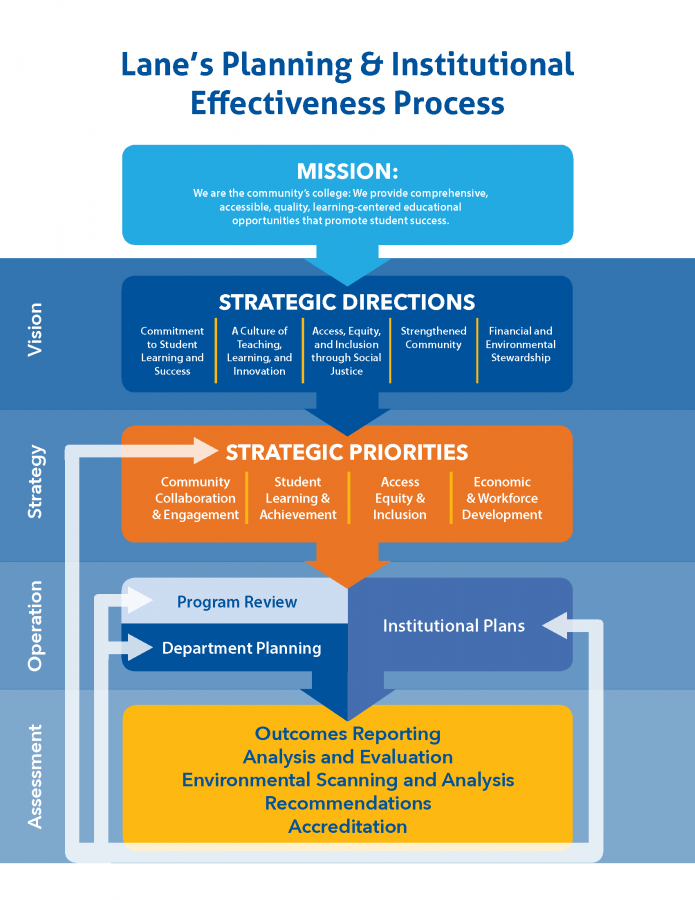Planning and Institutional Effectiveness (PIE)
Below is a description and diagram of Lane's current planning and institutional effectiveness model, which is "under construction" and will emerge as the integrated planning framework. This page also provides links to the Economic Impact Study, Program Demand Gap Analysis, and the Environmental Scan Reports.
In May 2023, Lane began developing an integrated planning framework, which will take approximately 36 months to fully implement. From May - August 2023, we began collating institutional goals and testing software systems. In August the administration prioritized efforts around the Strategic Plan. Simultaneously, we are beginning to map and align institutional-level goals. Stay tuned for next steps and future opportunities to get involved and/or read the resources below.
Snapshot of Integrated Planning at Lane
Definitions of & Differences Between Planning Types
Lane's planning and institutional effectiveness model is designed to support and further the college’s mission, with a focus on student learning and success. The model forms the basis for regular and effective assessment, improvement, accomplishment, and adaptation.
Strategic goals and objectives are established every five years as part of a comprehensive strategic planning process that identifies priority actions needed to support and improve achievement of Lane’s mission, as measured by mission fulfillment indicators.
Program review and department planning support strategic goals and objectives by operationalizing priorities and improvements at the program and service level.

About Planning and Institutional Effectiveness
Planning and Institutional Effectiveness is a continuous process of assessment and improvement that leads to the achievement of program, department/division, and institutional goals and outcomes and fulfillment of our mission.
Assessment processes and practices determine whether our efforts and actions are bringing forth desired results.
Program and Service Level Assessment
Program Review
Annual Department Planning
Institutional Assessment
Assessment of Student Learning
Mission Fulfillment
Accreditation Self Study
Improvement & plans are designed to address issues and opportunities identified through assessment.
Program and Service Level Improvement
Program Review Action/Implementation Plans
Annual Department Planning
Institutional Improvement
Strategic Plans
Institutional Initiatives
Key Tenets of Planning and Institutional Effectiveness
Comprehensive, Integrated, and Ongoing Planning
There is consistent and continuous commitment to improving student learning. Educational effectiveness is a demonstrable priority in all planning structures and processes.
Informed by Data and Analysis
Data and analyses are widely distributed, understood, and used throughout the College.
Broad-Based Participation and Engagement
There is dialogue about planning and institutional effectiveness that is ongoing, robust, and pervasive.
Implementation, Evaluation, and Adaptation
There is ongoing, systematic review and adaptation of evaluation and planning processes. The College uses evaluation and planning to refine its key processes and improve student learning.
Planning Guides Resource Allocation
Formal planning and assessment practices guide resource allocation. The College effectively uses its human, physical, technology, and financial resources to achieve its broad educational purposes, including stated learning outcomes.
Resources
Institutional Effectiveness is involved with strategic planning at the college. You can view the college strategic plans, including the SEM Plan, on the College Initiatives website.
The following three (3) reports will be written on a three-year rotating cycle. Together, these reports provide valuable information to help stakeholders make evidence-informed decisions.
Economic Impact Study
Lane has a considerable impact on the local economy. According to a Lightcast (formerly Emsi Burning Glass) study, from 2021-22, Lane added $674.6 million in income to the service district. This equals about 3.3% of our region’s gross regional product. That amount translated to employment is equivalent to 8,898 jobs and about one out of every 24 jobs. For every dollar invested in Lane, people in Oregon gain $5.80 in added income and social savings.
For every dollar students invest in their education at Lane they receive an additional $4.80 in lifetime earnings. That means that students’ average annual rate of return for their investment in their education is 18.4%.
Learn more about the economic value of Lane Community College by reading the resources below.
The previous study is below. Please note that the 2018/19 and 2021/22 reports are not intended to be compared due to changes in the Lightcast methodology and the service area.
Program Demand Gap Analysis
The Program Demand Gap Analysis is based on Lane County and LCC data. It compares job openings and LCC educational program completions to identify opportunities to consider.
Environmental Scan
The LCC Environmental Scan Report 2022 reveals trends that are likely to impact Lane in the next 2-3 years. Topics such as economic, social, political, environmental and more are covered in this in-depth report created by the IEC Environmental Scan Subcommittee.
Need info quick? Read the report's executive summary or the one-page summaries below.
EScan Section Overview: Social Trends
